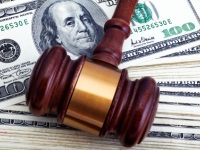
In a comprehensive tour of the Private Securities Litigation Reform Act’s (“PSLRA”) safe-harbor provisions, on November 22, 2016, a federal court in Massachusetts dismissed a shareholder class-action lawsuit against Neovasc, Inc. In holding that Neovasc’s ultimately faulty predictions concerning the outcome of a trade secrets lawsuit fell within the PSLRA’s safe harbor, the court rejected the plaintiff’s attempts to import a scienter requirement into the safe-harbor inquiry, among other things, and dismissed the complaint without leave to amend.
This putative class-action came on the heels of a $70 million jury verdict against Neovasc in May 2016. In that case, a jury found that Neovasc misappropriated certain trade secrets from CardiAQ Valve Technologies after CardiAQ had severed its manufacturing relationship with Neovasc, and Neovasc had patented a competing product. Neovasc’s stock price fell approximately 75 percent when the jury verdict was announced. Shortly after the verdict and stock decline, shareholders filed the class action, alleging securities fraud under Section 10(b) of the Securities Exchange Act of 1934 and Rule 10b-5 thereunder. The plaintiff alleged, among other things, that prior to the verdict, Neovasc CEO Alexei Marko mischaracterized the lawsuit as “baseless,” and that Neovasc had misstated that the suit was “without merit” in the company’s SEC filings.
In moving to dismiss the class-action, Neovasc argued that all of the challenged statements were forward-looking and thus fell within the PSLRA’s safe-harbor provisions. The court agreed, finding that the statements were (1) forward-looking, and (2) accompanied by meaningful cautionary language. As to the forward-looking nature of the statements, the court explained that a statement is forward-looking if its accuracy can only be verified after the statement is made. It follows that statements calling the trade-secrets suit baseless or without merit were forward-looking because their accuracy could only be verified in the future once the outcome of the trade-secrets case was known. The court also found that the statements included meaningful cautionary language. The court distinguished Neovasc’s cautionary language from boilerplate warnings that might not qualify for safe-harbor protection, pointing to statements in Neovasc’s SEC filings, such as a warning that “[i]f we are unsuccessful in our defense of these claims . . . we may be faced with significant monetary damages.” The court found that this and other specific cautionary language was enough to fall under the safe harbor.
In addition, the court rejected two arguments from the plaintiff which misinterpreted the safe-harbor statute. First, the plaintiff argued that the safe-harbor did not apply because he had pled sufficient facts to demonstrate that the challenged statements were made with actual knowledge of their falsity. The court held that plaintiff’s argument was based on a misreading of the statute. As the court explained, proof of known falsity only eliminates safe harbor protection where meaningful cautionary language is lacking. In other words, even if a defendant knew the statements were false or misleading, if there was sufficient cautionary language, the statements are not actionable.
Second, the court rejected the plaintiff’s argument that, even if the statements were partially forward-looking, the complaint targeted “embedded assertions of present fact,” which were not protected. The plaintiff argued that Neovasc’s statements that the trade-secrets suit was without merit were false statements of present belief, not projections. But the court explained that virtually every statement about a future event could be said to imply a statement of present belief. Examining an alleged present belief apart from the forward-looking aspects of the statement would require an inquiry into the state of mind of the maker of the statement, however, something that the court found the safe-harbor statute does not allow for. Thus, the court found that treating projections as containing implicit statements of present fact would render the safe-harbor protections meaningless, and rejected the plaintiff’s argument.

